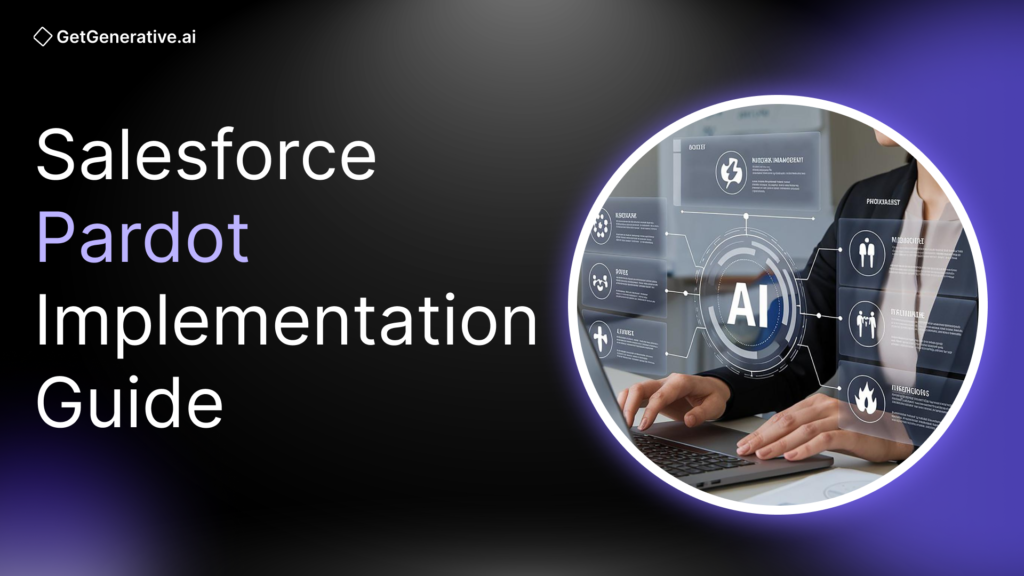Salesforce Pardot Implementation Guide 2025
Marketing automation has evolved from a tactical tool into a strategic engine for modern B2B organizations. Today, over 50% of companies rely on marketing automation platforms, and the average return is impressive — $5.44 for every $1 invested, with a payback period of less than six months.
Among the top-tier platforms, Salesforce Pardot — now branded as Marketing Cloud Account Engagement — stands out. Purpose-built for B2B enterprises, Pardot helps streamline lead generation, personalize engagement, and drive revenue growth through unified marketing and sales operations. For senior Salesforce professionals and CXOs, Pardot implementation is no longer just a tech project — it’s a growth initiative.
This guide offers advanced insights and industry-proven strategies to help you implement Pardot effectively in 2025 and beyond. Backed by real-world examples and best practices, it covers every step from planning and setup to advanced optimization.
What to Do Before You Implement Pardot
Pardot success starts long before the first campaign launches. In fact, up to 60% of marketing automation projects fail to meet expectations due to a lack of planning or misaligned goals. Avoid becoming a cautionary tale by following these pre-implementation strategies:
1. Define Business Goals and KPIs
Tie your Pardot goals directly to business outcomes. Some examples:
- Increase MQLs by 30% in six months
- Reduce sales cycle by 20%
- Improve campaign ROI by 25%
Support these goals with KPIs like:
- MQL to SQL conversion rate
- Marketing contribution to pipeline
- Cost per lead (CPL) and customer acquisition cost (CAC)
These metrics not only guide configuration but also demonstrate value to executives.
2. Secure Executive Buy-In and Cross-Team Alignment
Pardot touches multiple departments — marketing, sales, IT, compliance. Ensure high-level sponsorship (ideally CMO or CIO) and involve stakeholders from the outset.
Crucially, align on lead definitions — what qualifies as an MQL vs. SQL. Misalignment is rampant: 90% of sales and marketing teams report disconnects when lead qualification criteria aren’t agreed upon. Create a Service Level Agreement (SLA) defining:
- What marketing delivers
- How and when sales will respond
- Joint accountability metrics
3. Audit Your Data and Assess Readiness
Your CRM data is the fuel Pardot runs on. Clean up:
- Duplicates
- Incomplete records
- Stale or unverified leads
Normalize fields critical for segmentation (e.g., industry, title, region), and review compliance with GDPR, CCPA, and CAN-SPAM.
Pro Tip: If you operate across geographies or business units, consider whether to use multiple Pardot Business Units (each with its own database and rules) or a single global instance. This decision has licensing and design implications — make it early.
4. Assign Roles and Identify Resource Gaps
You’ll need more than just tech know-how to succeed. Assemble a team including:
- Pardot-certified specialists
- Salesforce admins
- Content creators and email marketers
- Campaign analysts
For complex orgs, consider partnering with a Salesforce implementation expert to speed setup and bring industry best practices. Also plan end-user training — even the best system fails if no one uses it properly.
Break your rollout into manageable phases:
- Phase 1: Setup, CRM integration, data sync
- Phase 2: Lead scoring, email templates, initial campaigns
- Phase 3: Nurture programs, advanced reporting, AI features
Establish quick wins in the first 30–60 days — like a basic lead nurture program or campaign dashboard — to show value early and build momentum.
How to implement Pardot with Salesforce?
Step 1. Salesforce Integration and User Management
Start by installing the Pardot Lightning App from the AppExchange and configure the Salesforce-Pardot Connector. This ensures real-time sync of leads, contacts, and campaigns between both platforms.
Key actions:
- User Sync: Leverage Salesforce User Sync to automatically create Pardot users based on Salesforce profiles. This simplifies access control and supports single sign-on.
- Field Mapping: Start with a whitelisted set of fields critical for segmentation and lead scoring. Avoid syncing every field to reduce clutter and potential errors.
- Lead Flow Logic: Define when a Pardot prospect becomes a Salesforce lead. For example, after reaching a score of 100 and a grade of B+, they can be auto-assigned to sales.
- Access Controls: Assign appropriate permissions for different user groups. Sales teams may use Salesforce Engage to send personalized, trackable emails, while marketing needs broader access to assets, automation rules, and campaign setup.
For large orgs, adopt a Center of Excellence model — designating internal champions who oversee usage, governance, and adoption.
Step 2. Technical Setup: Domains, Authentication, and Tracking
Pardot’s technical setup ensures emails are deliverable and activities are trackable.
Must-do items:
- Tracking Domain: Set up a branded domain (e.g.,
go.yourcompany.com) for email links and landing pages. This helps with brand recognition and deliverability. - Email Authentication: Implement SPF and DKIM records in your DNS settings to authenticate your domain. This step is critical — without it, emails are likely to land in spam folders.
- Website Tracking: Embed Pardot’s tracking code on your site (ideally via a tag manager or site template). This lets Pardot track visitor behavior like page views and time on site, enhancing scoring accuracy.
- Connector Integrations: If your marketing stack includes webinar tools (Zoom, GoToWebinar), Google Ads, or LinkedIn, configure Pardot connectors now. This simplifies campaign tracking and ensures lead capture across platforms.
By establishing a secure and scalable infrastructure, your team can confidently build campaigns that perform reliably.
Step 3. Lead Scoring, Grading, and Segmentation
Pardot helps prioritize leads not just based on activity, but also fit.
Scoring assigns points based on engagement:
- Email open: +5
- Form submission: +50
- Webinar attendance: +70
- Unsubscribe: -10
Grading ranks how closely a prospect aligns with your ideal customer profile (ICP):
- VP of Marketing in Software: A
- Student in Education: D
Work with sales to customize the default model. For example, if demo requests strongly correlate with closed-won deals, assign them high scores. Segment your audience dynamically using rules like “Healthcare Prospects in Midwest with Grade B+ or higher.” These lists power targeted emails and nurture campaigns.
Step 4. Connected Campaigns and Campaign Structure
Enable Connected Campaigns to unify marketing attribution across Salesforce and Pardot. This ensures that:
- A campaign created in Salesforce also exists in Pardot
- Engagement (email clicks, form fills) auto-rolls up into Salesforce reports
- Attribution for pipeline and revenue becomes end-to-end
Create a consistent campaign hierarchy:
Parent Campaign: “2025 Product Launch”
Child: “Product Webinar Series”
Child: “Q2 Email Campaigns”
Child: “LinkedIn Lead Gen”
Use Campaign Member Sync to keep Pardot lists and Salesforce campaign members in lockstep, simplifying reporting and segmentation.
Step 5. Content Creation: Emails, Forms, and Landing Pages
A Pardot system is only as powerful as the assets behind it. During implementation, build a core content library:
- Mobile-optimized email templates (nurtures, promos, newsletters)
- Reusable landing page templates
- Branded forms and thank-you pages
- Form handlers for 3rd-party form systems
Dynamic Content is a game-changer: show different content to different prospects based on attributes like industry or lifecycle stage. Use personalization tokens to include first names, companies, or last touched product — boosting relevance and open rates.
Insight: 56% of B2B buyers expect personalization across channels — Pardot makes this scalable.
Step 6. Lead Nurturing with Engagement Studio
Build automated nurture journeys using Engagement Studio, Pardot’s drag-and-drop flow builder.
Example:
Email 1 → Wait 3 days
If opened → Send Webinar Invite
If not → Send eBook follow-up
If no action after 7 days → Send Case Study
Set up core tracks like:
- New Prospect Welcome
- Webinar Follow-Up
- Inactive Re-Engagement
- MQL Warm-Up
Ensure coordination with sales outreach. For instance, if a lead is in an open opportunity, suppress further nurture emails to avoid overlap.
Step 7. Testing, Training, and Launch
Before go-live:
- Test form submissions, autoresponder emails, scoring, and Salesforce sync
- Confirm email deliverability using spam analysis tools
- Review visibility of Pardot activity inside Salesforce lead/contact records
- Train sales teams on Pardot score/grade interpretation
- Prepare marketing with guides on campaign building and reporting
Aligning Marketing and Sales for Long-Term Success
1. Unified Metrics and Dashboards
Use Salesforce and Pardot’s connected reporting to create dashboards that both marketing and sales teams can trust and use together. Examples include:
- MQL volume and conversion rates
- Marketing-sourced pipeline contribution
- Campaign attribution to closed-won deals
- Sales follow-up rate on marketing leads
When leadership from both departments reviews the same data during pipeline meetings, it promotes transparency and joint accountability.
2. Service Level Agreements (SLAs) for Lead Handoff
Define what constitutes an MQL — e.g., Score >100 and Grade ≥ B — and agree on handoff rules. For instance:
- When an MQL is created, Pardot alerts the assigned sales rep via email and Salesforce task
- The sales rep must respond within 1 business day
- After 7 days of no activity, the lead is flagged for re-routing or re-nurturing
Document this SLA in a visual flowchart and circulate it to both teams. This eliminates finger-pointing and ensures leads don’t fall into a black hole.
3. Empowering Sales with Pardot Tools
Engage sales teams through tools like:
- Salesforce Engage – Allows reps to send trackable 1:1 emails using marketing-approved templates
- Real-time Alerts – Notifies reps when their leads take high-value actions (e.g., visits pricing page or opens email multiple times)
- Prospect Activity Feed – Embedded in Salesforce, this provides a timeline of a lead’s marketing engagement
Schedule brief weekly syncs between sales and marketing ops to review lead quality and campaign impact — this tight feedback loop enables rapid optimization.
📊 Stat: Companies with strong marketing-sales alignment are 67% better at closing deals and grow 19% faster on average.
4. Ongoing Collaboration
Host quarterly review meetings with both departments to:
- Review marketing-generated pipeline
- Identify underperforming campaigns
- Gather sales insights on prospect objections or content gaps
- Preview upcoming marketing campaigns so sales can prepare follow-up
This builds a culture where marketing and sales collaborate, not compete — and where Pardot becomes a shared growth engine.
Also Read – Salesforce Financial Cloud Implementation Guide
Real-World Success Stories: Pardot in Action
Case Study 1: VMware – 641% ROI Through AI and Automation
Global tech leader VMware used Salesforce Pardot to unify their marketing and sales teams, integrate predictive lead scoring, and streamline nurture programs. By deploying Einstein AI for smarter lead qualification and optimizing lead handoffs, they achieved:
- 20% increase in sales productivity
- 20% uplift in revenue
- 641% ROI on their Pardot investment
VMware’s success wasn’t about sending more emails — it was about focusing sales on the best leads at the right time, using AI-backed insights and automated workflows to scale intelligently.
Case Study 2: Global Electronics Manufacturer – 22% Increase in Lead Conversion
A multinational electronics company implemented Pardot to break down marketing-sales silos and revitalize lead engagement. Key actions included:
- Integrating Pardot with Salesforce for unified prospect views
- Launching dynamic content campaigns with personalized landing pages
- Re-engaging dormant leads through automation
Results:
- 27% increase in lead generation
- 22% increase in lead-to-customer conversions
- 35% lift in content downloads from optimized forms
- 12% improvement in email engagement
This shows Pardot’s impact extends beyond tech — even traditional sectors like manufacturing benefit from digital alignment and automation.
Related Read – Salesforce CRM Implementation With AI – The Ultimate Guide
How to optimize Salesforce Pardot after implementation?
After implementing Salesforce Pardot, continuously optimizing your campaigns for better performance is essential. Here are some tips:
- Regularly review and update your lead scoring and grading model
- A/B test your marketing assets to improve conversion rates
- Segment your audience for more targeted campaigns
- Use dynamic content to personalize your campaigns
- Leverage pardot’s reporting and analytics to measure and optimize campaign performance
Troubleshooting common issues in Pardot implementation
While implementing Salesforce Pardot, you may encounter some common issues that can hinder your progress or affect your campaigns’ performance. Here are some of the most common problems and how to troubleshoot them:
Sync issues between Pardot and Salesforce:
- Ensure the Salesforce Connector is properly configured and the appropriate user permissions are set up.
- Check that the field mapping between Pardot and Salesforce is accurate and complete.
- Verify that no conflicting triggers or workflows in Salesforce may interfere with the sync process.
- If the issue persists, consider resyncing your data or contacting Salesforce support for assistance.
Also Read – Salesforce B2B Commerce Implementation Guide
Tracking code not firing correctly:
- Double-check that the Pardot tracking code is properly installed on all website pages.
- Ensure that the tracking code is placed in the correct location within the HTML code (just before the closing </body> tag).
- Test the tracking code using a tool like Google Tag Manager or a browser extension to ensure it’s firing correctly.
- If the issue persists, consider contacting Pardot support for further guidance.
Deliverability issues with emails:
- Ensure that your email authentication settings (SPF, DKIM, and DMARC) are properly configured in Pardot.
- Monitor your email reputation and sender score using tools like Return Path or Sender Score.
- Regularly clean your email lists to remove inactive or invalid email addresses.
- Follow best email content and design practices, such as using a clear subject line, including an unsubscribe link, and optimizing for mobile devices.
- If deliverability issues persist, consider working with a deliverability expert or contacting Pardot support for assistance.
Inconsistent data between Pardot and Salesforce:
- Verify that the field mapping between Pardot and Salesforce is accurate and complete.
- Check for any conflicting data in Salesforce, such as duplicate records or inconsistent field values.
- Ensure that your data is synced regularly and there are no sync errors or failures.
- Consider performing a manual data import or export to reconcile inconsistencies between the two systems.
Difficulty creating or editing assets in Pardot:
- Ensure you have the appropriate user permissions to create and edit assets in Pardot.
- Check using supported file types and sizes when uploading images or documents.
- Verify that you have enough storage space in your Pardot account to accommodate new assets.
- If you encounter any error messages or unexpected behavior, try clearing your browser cache and cookies or using a different browser.
Poor campaign performance or low engagement:
- Review your campaign strategy and ensure you target the right audience with relevant content.
- Optimize your email subject lines, content, and calls to action to improve open and click-through rates.
- Test different email send times and frequencies to find the optimal schedule for your audience.
- Review and update your lead scoring and grading models regularly to ensure that you are prioritizing the most engaged and qualified leads.
Related Read – Salesforce Implementation With AI Guide
Conclusion
Salesforce Pardot implementation is a powerful way to streamline your marketing efforts and drive better results. By following best practices, setting up Pardot correctly, and continuously optimizing your campaigns, you can unlock the full potential of this marketing automation platform.
Looking to simplify how you manage Salesforce projects — from proposal to go-live?
GetGenerative.ai offers an AI-powered workspace with agents that help you handle everything end to end — scope planning, documentation, and even creating your implementation roadmap.
If you’re curious to see how it works, book a demo — no pressure, just a chance to explore what’s possible.
Frequently Asked Questions (FAQs)
1. Can Pardot be used without Salesforce?
Pardot can be used as a standalone product, but it’s most effective when integrated with Salesforce.
2. How long does Salesforce Pardot implementation take?
The implementation timeline varies depending on the complexity of your setup and integrations. It can take anywhere from a few weeks to a few months.
3. What kind of support does Salesforce offer for Pardot implementation?
Salesforce offers comprehensive documentation, training resources, and support options to help with Pardot implementation, including access to the Pardot Success Center and the Trailblazer Community.




